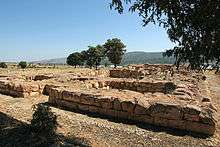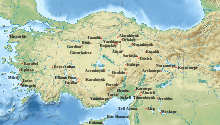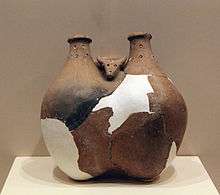Sapinuwa
Sapinuwa (sometimes Shapinuwa; Hittite: Šapinuwa) was a Bronze Age Hittite city at the location of modern Ortaköy in the province Çorum in Turkey. It was one of the major Hittite religious and administrative centres, a military base and an occasional residence of several Hittite kings. The palace at Sapinuwa is discussed in several texts from Hattusa.
 | |
 Shown within Turkey | |
| Location | Çorum Province, Turkey |
|---|---|
| Region | Anatolia |
| Coordinates | 40°15′18.03″N 35°14′9.70″E |
| Type | Settlement |
| History | |
| Cultures | Hittite |
| Site notes | |
| Condition | In ruins |
Digs

Ortaköy was identified as the site of ancient Sapinuwa during a survey in 1989, and Ankara University quickly obtained permission from the Ministry of Culture to begin excavation. This commenced in the following year. Building A was excavated first, and then Building B in 1995. The building with the Yazılıkaya-style orthostate and 14th century BC charcoal was excavated after 2000. Aygül Süel has been the head of excavations at this site from 1996 onwards.
In the first excavated region was a Cyclopean-walled building dubbed "Building A". Building A has yielded 3000 tablets and fragments. They were stored in three separate archives on an upper floor, which collapsed when the building was burnt.
At Kadilar Hoyuk, 150 metres southeast of Building A, "Building B" has proven to be a depot filled with earthenware jars. Another building features an "orthostat that looks like the relief of Tudhaliyas at Yazilikaya".
Findings

The fire which destroyed Sapinuwa also damaged its archive. Most of the tablets are fragmentary, and must be pieced together before interpretation and translation.[1]
Identification of the site as Sapinuwa[2] immediately corrected a misunderstanding in Hittite geography. Due to the archives so far discovered at Hattusas, Sapinuwa had been thought to be a primarily Hurri-influenced city. Scholars of the Hattusas archive therefore positioned Sapinuwa to the southeast of Hattusa. Now Sapinuwa (and therefore the cities associated with it) are known to be to Hattusas's northeast.
The Building A tablets are mostly in Hittite (1500); but also in Hurrian (600), "Hitto-Hurrian", Akkadian, and Hattian.[3] In addition, there are bilingual texts, not heretofore known, in Hittite / Hattian and in Hittite / Hurrian; vocabulary lists in Hittite / Sumerian / Akkadian; and seal impressions in Hieroglyphic Luwian. The Hittite texts include many letters; Hurrian was mostly used for itkalzi (purification) rituals.[3] Several of the letters corresponded with those mentioned in the Maşat Höyük archive. The dialect of Hittite in that correspondence was Middle Hittite, but the site was in use for centuries afterward.[4][5]
The first English-language publication from the excavation was by Aygul Süel, 2002.[6] As of 2014,[7] the archive had not been published. The first English-language publication of any text, a fragmentary vocabulary text listing useful plants, perhaps an advanced school tablet of the 14th century BCE, along with further discussion of the site, appeared in Aygul Süel and Oguz Soysal, "A Practical Vocabulary from Ortakoy";[8] also published is a letter from a queen.[9]
History

Focus on Ortakoy writes, "The strategic location of Shapinuwa is very important. The mountains surrounding the city, the plateau ascending in terraces on the Amasya Plain, and the fortification facilities starting as far as 5 km enable the city to be easily defendable. Since the city has a key location in between Alaca and Amasya plains, as long as the city, which is two-days distance from Hattusas, stands still, the roads to Bogazkoy - Hattusas are under control. As well as there are traces of military and religious architecture of the upper city on the hills to the west, the need for water and timber were being supplied from these hills."[10]
The Hittites commonly invoked the Storm God of Sapinuwa alongside the Storm God of Nerik. Since Hattusa was to the south and Nerik likely further north, both initially Hattic-speaking; given the presence of the Hattic language in the Sapinuwa archive (and apparent paucity of the Palaic language); and given that its name makes sense in Hattic as a theophoric (sapi, "god"; Sapinuwa, "[land] of the god"): it is likely that Hattians founded Sapinuwa as well. In that case, the Nesite-speaking people would have taken over Sapinuwa at the same time they took Nerik and Hattusa, in the 17th century BC.
The Hittites' enemy at that frontier during the 15th century BC were the Kaskas.
Oguz Soysal wrote, "The excavators of Ortaköy believe that this city was a second capital of the Hittites or a royal residence, for a specific period, namely during the Middle Hittite Kingdom, ca. late 15th century B.C."[5] However, "Most of the epigraphic finds are dated to the last phase of the Hittite Middle Kingdom (ca. 1400-1380 B.C.)", contemporary with Tudhaliya I and the archive at Maşat Höyük.
It is presumed that the Kaska were responsible for the 14th century BC burnings which turned some of the building materials into coal. The Hittite court moved away, probably to Samuha, and did not rebuild Sapinuwa.
See also
- Cities of the Ancient Near East
- Short chronology timeline
References
- Süel (2002), pp. 157–166, 163.
- Aygul Süel, M. Süel (K. Kamborian, tr.) "Sapinuwa : Découverte d'une ville hittite", Archaeologia (1997:68-74).
- Süel (2002), p. 163.
- Süel (2002), p. 165.
- Oguz Soysal, on behalf of the Ortaköy-Sapinuwa Epigraphical Research project, summarizes the contents that the documents include as "letters, lists of persons, tablet-catalogs, oracular texts, prayers, rituals and festival descriptions". Description of the Ortaköy-Sapinuwa Epigraphical Research project Archived August 20, 2006, at the Wayback Machine
- Süel (2002); see review by Billie Jean Collins in Bulletin of the American Schools of Oriental Research, No. 337 (February 2005):96), called the only English-language report to date.
- Mark Weeden (2014). "State Correspondence in the Hittite World". In Karen Radner (ed.). State Correspondence in the Ancient World. Oxford University Press. pp. 32–63, 215–222. Also Trevor Bryce (2006). "Preface". The Kingdom of the Hittites, new ed. Oxford University Press. pp. xvii. ISBN 978-0-19-928132-9.
- Süel, Aygul; Soysal, Oguz (2003). "A Practical Vocabulary from Ortakoy". In G. Beckman, R. Beal, and G. McMahon (eds.) (eds.). Hittite Studies in Honor of Harry A. Hoffner Jr. on the Occasion of His 65th Birthday. Winona Lake: Eisenbrauns. pp. 349–365.CS1 maint: uses editors parameter (link)
- Süel (2002), p. 158, figure 1
- Focus on Ortakoy ...
Sources
- Süel, Aygul (2002). "Ortaköy-Sapinuwa". In Hans Gustav Güterbock, K. Aslihan Yener, Harry A. Hoffner, and Simrit Dhesi (eds.) (eds.). Recent developments in Hittite archaeology and history. Eisenbrauns. pp. 157–166.CS1 maint: uses editors parameter (link)
External links
| Wikimedia Commons has media related to Šapinuwa. |